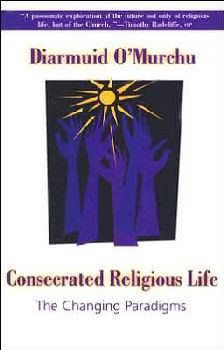
|
Posted March 24, 2006
Book: Consecrated Religious Life: The Changing Paradigms Author: Diarmuid O’Murchu Orbis Books, Maryknoll, NY, 2005, pp.267 An Excerpt from the Jacket:
An Excerpt from the Book: Consciousness and the Liminal Threshold Liminal witness is about renaming reality in a way that will make a difference, in a way that unveils deeper, liberating truth. This means mutual engagement with the cynicism and disillusionment which are widespread in our contemporary world. More importantly, it means striving to discern the awakening aspirations for meaning and hope, the aching cries arising from broken lives in rich and poor countries alike. Perhaps most important of all, it means a massive reclaiming of human and spiritual imagination so that we can begin to recreate narratives that liberate and articulate what the Spirit is striving to set free in our time. To this end, the liminar is faced with some formidable challenges: 1. Can we be catalysts that facilitate the death of the old while being midwife to the birth of the new? This involves freedom to grieve, lament and let go! But most challenging of all, it means transcending the denial, anger and bargaining of the grieving process, so that we can be freed to “bury the dead.” Only when we have laid the old to rest — old politics, economics, religion, and patriarchal power games — will we be free to embrace the new. 2. Meanwhile, we must start telling new stories, alternative visions of how things might be for a different future. This future will be built on the shoulders of the old, but true to authentic Resurrection hope, it will contain dimensions that will be totally new and unexpected. In this task, liminal people face a daunting challenge – not about evoking the future, but about appropriating the past. For our mainstream institutions, the only past that carries credibility is that of the past 5,000 years; the rest tends to be dismissed as fanciful nostalgia for some long-lost golden age. This cultural, historical shortsightedness has left us with a stultified, truncated story ensuing in massive disconnection and alienation from the nurturing sustaining creation to which we all belong. 3. This cultural retardation creates several hurdles as we seek to bring an enlarged vision to our petrified world. What the liminal people need to confront more than anything else – is the shriveled-up consciousness with which the dominant culture perceives and understands. The rational, reductionistic, controlling mind has reaped havoc on imagination and creativity, leaving humanity with a grossly inflated will-power, constantly battling our way to “freedom” from our self-made crippling isolation. We need to start thinking afresh, thinking big, thinking globally and cosmically, thinking and seeing as God does. This is the heart of contemplation for our time. If humanity wants to survive the 21st century, and reclaim a more wholesome place witin the cosmic and planetary creation, the threshold witness of the liminal people is crucial. It will not be the first time – in which those committed to the vowed life were drawn from the monastery to the world. And, I expect, it will not be the last time taht we will surprise ourselves by the way we will have responded to the radical grace of divine giftedness. Table of Contents: 1. What have paradigms got to do with religious life? 2. Paradigms in decline 1. The God-image of 2000 years 2. Patriarchal religion 3. The power of dualisms 4. Ecclesiastical, canonical control 5. Preoccupation with the sinful world 6. The soul over the body 7. Obedience unto death 3. Paradigms in transition 1. Catholicism in a new guise 2. Spirituality vis-a-vis religion 3. Flee the world/ embrace creation 4. Women’s redemptive rage 5. The Church vis-a-vis the kingdom of God 6. Consecration – communion – mission 7. Mission vis-a-vis ministry 8. New models of leadership 4. Paradigms coming to birth 1. The world is bigger than the Church 2. Liminality for the lay vocation 3. Calling forth the adult 4. Community for discernment 5. Vowed commitment to erotic liberation 6. Vowed commitment to justice-making 7. Vowed commitment to right relating 8. Contemplating new horizons of consciousness |
|
